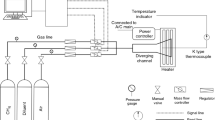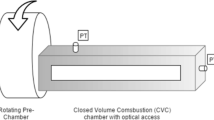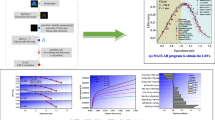Abstract
Two-fluid model and divisional computation techniques were used. The multi-species gas fully N-S equations were solved by upwind TVD scheme. Liquid phase equations were solved by NND scheme. The phases-interaction ODE equations were solved by 2nd Runge-Kutta approach. The favorable agreement is obtained between computational results and PLIF experimental results of iodized air injected into a supersonic flow. Then, the numerical studies were carried out on the mixing of CH 4 and kerosene injected into a supersonic flow with H 2 pilot injection. The results indicate that the penetration of kerosene approaches maximum when it is injected from the second injector. But the kerosene is less diffused compared with the gas fuels. The free droplet region appears in the flow field. The mixing mechanism of CH 4 with H 2 pilot injection is different from that of kerosene. In the staged duct, H 2 can be entrained into both recirculation zones produced by the step and injectors. But CH 4 can only be carried into the recirculation between the injectors. Therefore, initiations of H 2 and CH 4 can occur in those regions. The staged duct is better in enhancing mixing and initiation with H 2 pilot flame.
Similar content being viewed by others
References
Kay I W, Peschke W J, Guile R N. Hydrocarbon-fueled ramjet combustor investigation[A]. AIAA Paper, 90-2337, 1990.
Waltrup P J. Liquid fueled supersonic combustion ramjets. A research prospective of the past, present and future[A]. AIAA Paper. 86-0158, 1986.
Andrews E H, Trexler C A, Emami S. Tests of a fixed-geometry inlet-combustor configuration hydrocarbon-fueled, dual-mode scramjet[A]. AIAA Paper, 94-2817, 1994.
Billig F S. Supersonic combustion ramjet technology missile[J]. J Propulsion and Power, 1995, 11(1): 1139-1146.
Narayanan A K, Damadaran K A. Experimental studies on piloted supersonic combustion using the petal nozzle[J]. J Propulsion and Power, 1997,13(1): 142-148.
Vinnogradov V A, Kobigsky S A, Petrov M D. Experimental investigation of kerosene fuel combustion in supersonic flow[J]. J Propulsion and Power,1995,11(1): 130-134.
Schetz J A, Kush E A, Joshi P B. Wave phenomena in liquid jet breakup in a supersonic crossflow[J]. AIAA J, 1980,18(7): 774-778.
Less D M, Schetz J A. Transient behavior of liquid jets injected normal to a high velocity gas stream[J]. AIAA J, 1986, 24(12): 1979-1986.
Igra O, Ben-Dor G. Dusty shock waves[J]. Applied Mechanics Rev, 1988, 41(11): 397-437.
Yee H C, Klopeer G H, Montagne J L. High-resolution shock-capturing schemes for inviscid and viscous hypersonic flows[J]. J Comp Phys,1990,88: 31-66.
ZHANG Han-xin, LI Zuo-wu. Numerical simulation to a hypersonic wake flow[J]. Acta Mechanica Sinica,1992, 24(4): 389-399. (in Chinese)
McDaniel J C, Graves J, Jr. A laser-induced fluorescence visualization study of transverse, sonic fuel injection in a non-reacting supersonic combustor[A]. AIAA Paper, 86-0507,1986.
Uenishi K, Rogers R C. Three-dimensional computational of mixing of transverse injector in a ducted supersonic airstream[A]. AIAA Paper,86-1423,1986.
Author information
Authors and Affiliations
Rights and permissions
About this article
Cite this article
Xu, Sl., Yue, Pt. & Han, Zy. Numerical Studies on the Mixing of CH4 and Kerosene Injected into a Supersonic Flow with H2 Pilot Injection. Applied Mathematics and Mechanics 22, 468–477 (2001). https://doi.org/10.1023/A:1016305919260
Issue Date:
DOI: https://doi.org/10.1023/A:1016305919260




